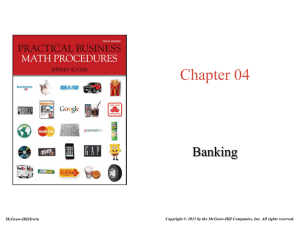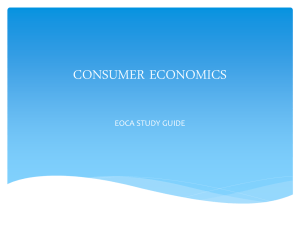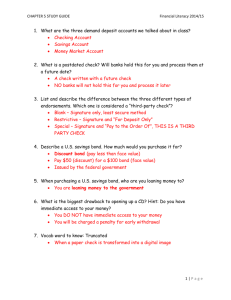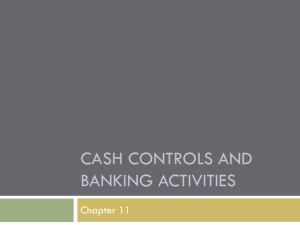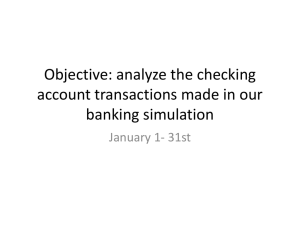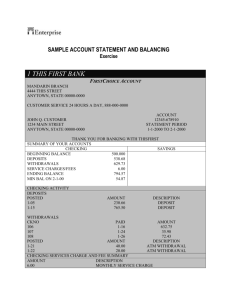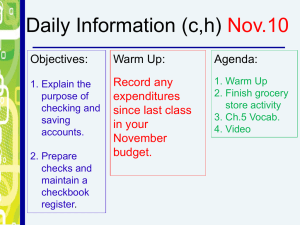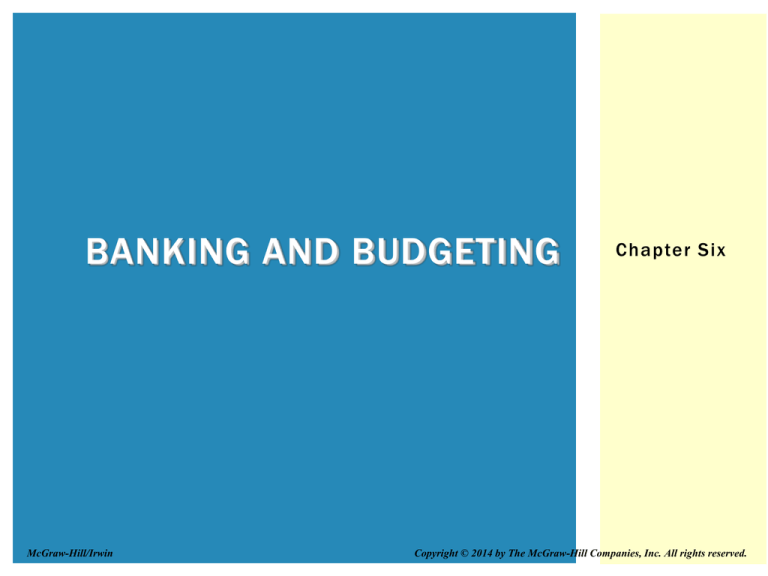
BANKING AND BUDGETING
McGraw-Hill/Irwin
Chapter Six
Copyright © 2014 by The McGraw-Hill Companies, Inc. All rights reserved.
LEARNING UNIT OBJECTIVES
LU 6 -1: T he Checking Account
1. Define and state the purpose of signature
cards, checks, deposit slips, check stubs,
check registers, and endor sements.
2. Correctly prepare deposit slips and write checks.
LU 6 -2: Bank St atement and Reconciliation Process; Latest Trends in
Mobile Banking
1. Explain trends in the banking industr y.
2. Define and state the purpose of the bank statement.
3. Complete a check register and a bank reconciliation.
4. Explain the trends in mobile banking.
LU 6 -3: T he Budgeting Process
1. Under stand the value of a budget .
2. Create a budget.
6-2
CHECKS/DRAFTS
Check/Drafts – A written order instructing a bank, credit union, or savings and loan
institution to pay a designated amount of your money on deposit with the bank to
a person or organization.
Drawer - One who writes
the check
Drawee – Bank
ordered to pay
Payee - To whom check
is payable
6-3
DEPOSIT SLIP
FIGURE 6.1
6-4
THE STRUCTURE OF A CHECK
FIGURE 6.2
6-5
TYPES OF COMMON ENDORSEMENTS
FIGURE 6.3
Blank
Full
Gracie’s Natural
Superstore 88190662
Pay to the order of
Ipswich Bank
Gracie’s Natural
Superstore 88190662
Can be further endorsed
Only person or company
named in the
endorsement can
transfer the check to
someone
Restricted
Pay to the order of
Ipswich Bank
For deposit only
Gracie’s Natural
Superstore 88190662
Limits any further
negotiation of the
check
6-6
USING THE CHECKING ACCOUNT
The check stub should be completed before the check is written.
6-7
TRENDS IN BANKING INDUSTRY
More businesses and people are using smar tphone apps from
lenders to do their banking transactions.
Electronic banking is convenient and usually charges significantly
lower fees, but does carr y some risk .
Check textbook website for the latest updates on banking bailouts
and government inter vention: www.mhhe.com/slater2014.
6-8
BANK STATEMENT
Bank Statement – A statement listing different types of activity that have
taken place during the month.
Debit: decreases the account —
Credit: increases the account +
6-9
BANK STATEMENT
FIGURE 6.4
6-10
BANK RECONCILIATION
Reconciles the dif ference between the bank statement and
the checkbook .
Checkbook
Bank Statement
Differences in timing
Transactions not entered in checkbook
6-11
RECONCILING CHECKBOOK WITH
BANK STATEMENT
Checkbook Balance
Bank Balance
+EFT (electronic funds transfer)
+Interest earned
+Notes collected
+Direct deposit
- ATM withdrawals
- Automatic withdrawals
-NSF check
-Online fees
- Automatic payments
-Overdraf ts
-Ser vice charges
-Stop payments
+/-Book error s
+Deposit in transit
-Outstanding checks
+/-Bank errors
Checkbook
Bank Statement
6-12
RECONCILING A BANK STATEMENT
5 Steps
Step 1. Identify outstanding checks.
Step 2. Identify deposits in transit.
Step 3. Analyze bank statement for transactions not recorded in check
register.
Step 4. Check for recording errors in checks, deposits, addition, or
subtraction.
Step 5. Compare the adjusted balances; if different, repeat Steps 1-4.
6-13
CHECK REGISTER
FIGURE 6.6
Used to track
written
checks
6-14
COMPLETING THE BANK
RECONCILIATION-- FIGURE 6.7
6-15
BANK RECONCILIATION
FIGURE 6.8
Checkbook Balance
Gracie’s checkbook balance
Add:
EFT leasing: Bakery dept.
EFT leasing: Meat dept. 4,228.00
Interest
Error: Overstated ck # 634
Deduct:
Service charge
NSF
EFT health insurance payment
GRACIE’S NATURAL SUPERSTORE
Bank Reconciliation as of March 31, 2013
Bank Balance
$6,588.42
Bank Balance
Add:
$1,808.06
Deposit in transit
56.02
720.00
$28.50
104.00
722.00
3,383.26
$15,246.28
6,812.08
$13,400.50
854.50
Deduct:
Outstanding checks:
No. 638
$572.00
No. 639
638.94
No. 640
166.00
No. 641
No. 642
Reconciled balance
$11,863.02
$12,546.00
406.28
917.06
Reconciled balance
2,700.28
$12,546.00
6-16
TRENDS IN MOBILE BANKING
Hottest Trend
Use of bank apps.
Free app to use with an iPad, iPhone, Android,
Blackberry, or Kindle.
6-17
THE BUDGETING PROCESS
A budget is a plan for spending that allows you to manage and
guide where money goes to maximize income and wealth.
Because money can be spent only one time, it has an
opportunity cost, the cost associated with all other possible
uses of that money, including saving and investing.
A line item is an element of a budget separately identified,
such as income or utilities.
6-18
THE BUDGETING PROCESS
The totals for income, fixed expenses, nonfixed expenses,
total expenses, and net profit (loss) assist with the analysis of
the budget whether it is for business or personal use.
Software programs such as Microsoft Excel, Microsoft Money,
or Quicken can create budgets.
6-19
HOW TO CREATE A BUDGET
4 Steps
Step 1. Record all sources of revenue (income); total.
Step 2. Create a list of monthly fixed cash outflows (expenses) and
monthly variable cash outflows (expenses); total.
Step 3. Determine whether there is a surplus or deficit by subtracting
the total in Step 2 from the total in Step 1.
Step 4. If there is a deficit, adjust the variable expenses accordingly. If
there is a surplus, determine the best use of that money, such as
research and development, investing, or saving.
6-20
PERSONAL MONTHLY BUDGET
FIGURE 6.9
6-21

